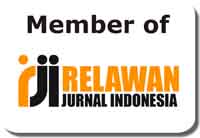An Analysis of Metadiscourse and Pragmatic Hedges in Fred Rogers’ Commencement Speech
Abstract
Keywords
Full Text:
PDFReferences
Abbas, A., Djatmika, D., Sumarlam, S., & Nurkamto, J. (2021). Functioning Expressive Speech Acts in the 2019 Indonesian Presidential Election Debates. Langkawi: Journal of The Association for Arabic and English, 7(1), Article 1. https://doi.org/10.31332/lkw.v7i1.2573
Astia, I. (2020). Politeness Strategy in Interlanguage Pragmatics of Complaints by International Students. Indonesian Journal of English Language Teaching and Applied Linguistics, 4(2), 349–362.
Bogdan, R., Taylor, S. J., & Taylor, S. S. (1975). Introduction to qualitative research methods: A phenomenological approach to the social sciences. Wiley-Interscience.
Borsuk, A. J. (2018, January 30). Everyone's neighbor: Mister Rogers' message continues to encourage. Journal Sentinel. https://www.jsonline.com/story/archives/2018/01/30/everyones-neighbor-mister-rogers-message-continues-encourage/1079857001/
Bougie, R., & Sekaran, U. (2019). Research methods for business: A skill building approach. John Wiley & Sons.
Brown, P., Levinson, S. C., & Levinson, S. C. (1987). Politeness: Some universals in language usage (Vol. 4). Cambridge university press.
Chueasuai, P. (2017). The Interpersonal Metafunction and Translation of Power Relations: A Case Study of Fifty Shades of Grey. Manusya: Journal of Humanities, 20(3), 1–22.
Ekawati, R., & Kurnia, F. D. (2018). Ideology Representation of 'Us' and 'Them' through Material Processes of Transitivity in Yudhoyono's Presidential Speech Texts. Proceeding Icon-ELite, 1(1), 449–456.
Erlinda, R. (2022). Teachers' Impoliteness Strategies in Providing Feedback in a Microteaching Class. Langkawi: Journal of The Association for Arabic and English, 8(2), 98–114. https://doi.org/10.31332/lkw.v0i0.3936
Firdaus, S. F., Soemantri, Y. S., & Yuliawati, S. (2021). A corpus-based study of self-mention markers in English research articles. International Journal of Language Teaching and Education, 5(2).
Fred Rogers Commencement Speech // University Honors // Marquette University. (n.d.). Retrieved April 9, 2022, from https://www.marquette.edu/university-honors/honorary-degrees/rogers-speech.php
Ginsburg, S., van der Vleuten, C., Eva, K. W., & Lingard, L. (2016). Hedging to save face: A linguistic analysis of written comments on in-training evaluation reports. Advances in Health Sciences Education, 21, 175–188.
Halimatussakdiah, Sibarani, R., & Fachry, M. E. (2020). The role of Tamiang’s local wisdom in decreasing postpartum depression: A linguistic anthropology study. Enfermería Clínica, 30(2), 491–493. https://doi.org/10.1016/j.enfcli.2019.07.145
Halliday, M. A. K. (1994). An Introduction to Functional Grammar (2nd edn)(London and Melbourne: Edward Arnold).
Hyland, K. (2005). Stance and engagement: A model of interaction in academic discourse. Discourse Studies, 7(2), 173–192.
Hyland, K. (2017). Metadiscourse: What is it and where is it going? Journal of Pragmatics, 113, 16–29.
Hyland, K., & Tse, P. (2004). Metadiscourse in academic writing: A reappraisal. Applied Linguistics, 25(2), 156–177.
Hyland, K., Wang, W., & (Kevin) Jiang, F. (2022). Metadiscourse across languages and genres: An overview. Lingua, 265(1), 103205. https://doi.org/10.1016/j.lingua.2021.103205
Kennedy, G. E., & Judd, T. S. (2007). Expectations and reality: Evaluating patterns of learning behaviour using audit trails. Computers & Education, 49(3), 840–855. https://doi.org/10.1016/j.compedu.2005.11.023
Kristiani, I., Sutopo, D., & Warsono, W. (2018). The Ideational Meaning in Khalil Gibranâ€TM s work †œThe Prophetâ€. English Education Journal, 8(4), 479–488.
Kuhi, D., & Mojood, M. (2014). Metadiscourse in Newspaper Genre: A Cross-linguistic Study of English and Persian Editorials. Procedia - Social and Behavioral Sciences, 98(1), 1046–1055. https://doi.org/10.1016/j.sbspro.2014.03.515
Liu, J. (2020). A Pragmatic Analysis of Hedges from the Perspective of Politeness Principle. Theory and Practice in Language Studies, 10(12), 1614–1619.
Liu, S., & Zhang, J. (2021). Using Metadiscourse to Enhance Persuasiveness in Corporate Press Releases: A Corpus-Based Study. SAGE Open, 11(3), 21582440211032164.
Miles, M. B., & Huberman, A. M. (1994). Qualitative data analysis: An expanded sourcebook. Sage.
Mohajer, L., & Jan, J. Mohd. (2015). Preserving Face and the Use of Hedges in Masculine World of Men. Procedia - Social and Behavioral Sciences, 208(1), 13–20. https://doi.org/10.1016/j.sbspro.2015.11.176
Mulatsih, S. (2008). Hedges: The Expressions of Doubt and Certainty. LITE: Jurnal Bahasa, Sastra, Dan Budaya, 4(2), 73–81.
Murakami, T., & Hashiya, K. (2014). Development of reference assignment in children: A direct comparison to the performance of cognitive shift. Frontiers in Psychology, 5(1), 523.
Omo, I. C., & Idegbekwe, D. (2020). Pragmatic Hedges in Editorials: A Focus on Vanguard, Guardian and Sun Newspaper Editorials in 2017. Journal of Translation and Language Studies, 1(1), 26–36.
Plappert, G. (2019). Not hedging but implying: Identifying epistemic implicature through a corpus-driven approach to scientific discourse. Journal of Pragmatics, 139(1), 163–174. https://doi.org/10.1016/j.pragma.2018.09.001
Qin, W., & Uccelli, P. (2019). Metadiscourse: Variation across communicative contexts. Journal of Pragmatics, 139(1), 22–39. https://doi.org/10.1016/j.pragma.2018.10.004
Robin Stern, opinion contributor. (2019, December 30). Mr. Rogers and the importance of social and emotional learning [Text]. The Hill. https://thehill.com/opinion/healthcare/476163-mr-rogers-and-the-importance-of-social-and-emotional-learning/
Salager-Meyer, F. (1994). Hedges and textual communicative function in medical English written discourse. English for Specific Purposes, 13(2), 149–170.
Sari, I. M. (2020). The Online Media Practice in Covering Indonesian National Police' s Prevention Efforts on the Prohibited Party' s Ideology Spread in Indonesia. 5(1), 149–165. https://ijeltal.org/index.php/ijeltal/issue/view/9
Siddiqui, A. (2018). "The Principle Features of English Pragmatics in Applied Linguistics". Advances in Language and Literary Studies, 9(2), 77–80.
Surono, S., Sumarlam, S., Wiratno, T., & Marmanto, S. (2021). Directive Speech Acts in Parenting and Politeness Implications Based on the Schools' Missions: A Study on Kindergarten Teachers in Teaching Learning Process in Yogyakarta. Langkawi: Journal of The Association for Arabic and English, 7(1), 66–80.
Tran, T. Q., & Duong, T. M. (2013). Hedging: A comparative study of research article results and discussion section in applied linguistics and chemical engineering. English for Specific Purposes World, 41(14), 1–13.
Wang, J., & Zeng, L. (2021). Disciplinary Recognized Self-Presence: Self-Mention Used With Hedges and Boosters in PhD Students' Research Writing. SAGE Open, 11(2), 21582440211005456.
Yuliana, D., & Imperiani, E. D. A. (2017). The realization of interpersonal meaning in course newsletters: A systemic functional linguistic perspective. Indonesian Journal of Applied Linguistics, 7(1), 181–188.
DOI: http://dx.doi.org/10.31332/lkw.v0i0.5423
Copyright (c) 2023 Intan Mustika Sari

This work is licensed under a Creative Commons Attribution-ShareAlike 4.0 International License.
Langkawi: Journal of The Association for Arabic and English indexed by:


















.png)
.png)

.png)
2.png)








